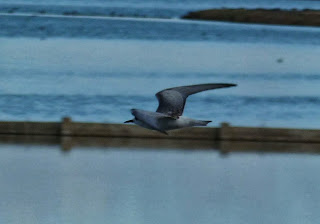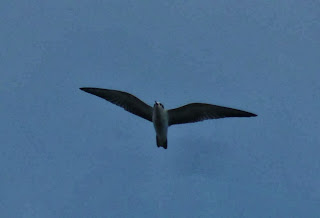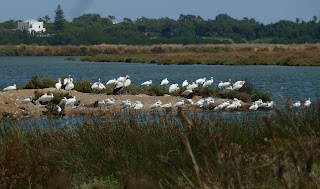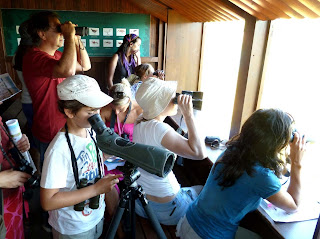Monday, September 30, 2013
White-winged Tern
I was delighted by this juvenile White-winged Tern (Chlidonias leucopterus) when visiting the seveage works just east of Faro on September, 13th. This eastern marsh-tern species is a rarity in Portugal, with about 20 records total to the present day. It was in company of an adult (moulting) Black Tern, many Ruff's and other wader species were also present at the location. Another highlight were no less than 3 Ospreys circling together. Bluethroat (adult female), Black-necked Grebes (3), Northern Pintail and Lapwing were firsts for the season.
Thursday, September 19, 2013
Sagres - autumn migration at the cape
During a day-tour to the cape-area near Sagres, we saw the following species (18th September 2013):
Spanish Imperial Eagle, Black Stork, Eleonora's Falcon, Bonelli's Eagle, Short-toed Eagle, Booted Eagle, Honey Buzzard, Peregrine, Gosh Hawk, Sparrow Hawk, Egyptian Vulture, Little Bustard, Red-billed Chough a.o.
Spanish Imperial Eagle, Black Stork, Eleonora's Falcon, Bonelli's Eagle, Short-toed Eagle, Booted Eagle, Honey Buzzard, Peregrine, Gosh Hawk, Sparrow Hawk, Egyptian Vulture, Little Bustard, Red-billed Chough a.o.
A great opportunity to visit the region and been introduced into its fantastic nature and birdlife is the upcoming Sagres Birdwatching-Festival, taking place October 4th to 6th 2013, organized by SPEA and Almargem.
Inscriptions for guided group visits, boat trips, walks, talks, workshops and many other activities are open. The program is available in English and Portuguese - for inscriptions and all Info visit:
Saturday, September 14, 2013
Great Shearwater today
Great Shearwater (Puffinus gravis) excellent views, 3 Ind., two birds swimming right next to the boat
Cory's Shearwater (Calonectris diomedea borealis) c. 35 Ind.
Sooty Shearwater (Puffinus griseus) 1 Ind., good views when showing up near boat and travelling on.
Shearwater sp. (Puffinus sp.) unidentified medium-sized SW travelling fast and distant, probably Balearic SW Puffinus mauretanicus.
Wilson's Storm Petrel (Oceanites oceanicus) 2 Ind., good views of one foreaging near boat.
European Storm Petrel (Hydrobates pelagicus) 3 Ind., plus two further, unidentified travelling SP.
Great Skua (Stercorarius skua) 4 Ind., very close views and cleptoparasitism.
Northern Gannet (Morus bassanus) c. 30 Ind.
A great trip despite the rain we catched during the trip - the first rain of the season. Next trip is scheduled for the 12th of October (still 4 vacancies) and one more around the 22nd of October, further trips on request, min. is 4 people to go out.
 |
| A Great Shearwater (Puffinus gravis) next to the boat. "His elegancy " in flight... |
Monday, September 9, 2013
Last weeks tours
My birding-week started early on Monday, 26th with a day-tour up to the Alentejo-plain, accompanied by an Australian birder and biologist and his German biologist friend. Bird of the day was an immature Rueppell's Vulture (Gyps rueppellii) feeding a on a carcass (sheep) in midst of well 150 Griffon Vultures and 5 Eurasian Black Vultures. On the digiscoping-shot I add here below, the difference in size (about 10% smaller and lighter built) and color (much darker and greyer brown, almost no contrast between mantle and wing feathers) are obvious. It is the third record of this African species I made in this region, the last one, made in company of a Swedish group in October 2012, I submitted to the Portuguese Rarities Committee (for other records, see here). I also know the species from the Strait of Gibraltar, where I saw it last September, near Algeciraz. There are also annual records for the Sagres-Peninsula now, made during the October/November passage of Griffon-flocks through the cape area.
Two days later, I have been in the area again, accompanied by an English photographer. The Black-bellied Sandgrouse were on our side that day, and we had them flying over close by. Also saw a large flock of about 100 Calandra Larks, the Iberian Grey- and Woodchat Shrikes, as expected, a juvenile Black Vulture and a few Griffons, Short-toed- and Booted Eagles and an impressive flock of Great Bustards flying by - a situation of which I am curious to see a photo... both, Black-eared Wheatears and Northern Wheatears were passing through, Little-ringed Plovers, Green- and Common Sandpipers and also some Black-winged Stilts were easily seen around small reservoirs in the area. A single Collared Pratincole was stopping over at a coastal lagoon on our way back. One remarkable situation I recall from the tour, was a Little Owl on a little wall beside the road, right next to the car, staying there and making the most extraordinary up- and down moves, expressing its state of alert (video would have been better!). I got one shot just with my compact camera through the car window (below).
Friday, 30th then, a morning in my "home-patch" here near Faro - with a French-American party of six. Willow- and Melodious Warblers, Spotted Flycatcher, Common Redstart, Sand Martins, Golden Oriole, Woodchat Shrike and Turtle Dove were among typical early autumn migrants here. Booted Eagle, the Black-winged Kite you see on top of this blog-post, Little Bittern, Glossy Ibis, Black-headed Weaver, Common Waxbill, Purple Swamphen, Flamingos, Spoonbills, of course the Azur-winged Magpie and several wader species, made it a successful morning.
Two days later, September 1st, I repeated this tour, with a Lady born in Peru. A rather rare sighting made that day was an Egyptian Mongoose (Ichneumon herpestris) showing up at a reed bed and then swimming a lake for about 50 meter to the reeds on the opposite side. Some aquatic birds nest very late, we saw a Great-crested Grebe with chicks that were only a few days old. A Sacred Ibis, technically also a rarity, fed near a large group of Spoonbills and Little Egrets.
Last Wednesday I have been guiding a birdwatching tour with the Algarve Siência Viva Centre here in Faro. They offer summer activities around science and nature for kids and their parents. Group size was 16 people and the language Portuguese!
Another Tour to the steppes, last Friday, including good views of two Golden Eagles and a walk here in Ludo, near Faro, were also productive, but I begin to look forward to trips to the cape-area now, our regional hot-spot for bird migration, as well as for further pelagic boat-trips, the next one being scheduled for this Saturday (September 14th) and almost fully booked. To be continued.
Another Tour to the steppes, last Friday, including good views of two Golden Eagles and a walk here in Ludo, near Faro, were also productive, but I begin to look forward to trips to the cape-area now, our regional hot-spot for bird migration, as well as for further pelagic boat-trips, the next one being scheduled for this Saturday (September 14th) and almost fully booked. To be continued.
Subscribe to:
Posts (Atom)














